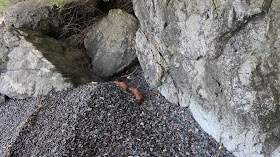I had a bit of time to visit American Camp in San Juan Island National Historic Park. The park is on the southern end of the island where the American military set up camp during the joint occupation of the San Juan Islands from 1859 through 1874. The American Camp section of the park has extensive prairie land. This prairie supports a rare butterfly, Euchloe ausonides insulanus - Island Marble butterfly.
This butterfly has gotten some recent news coverage regarding the efforts to protect the species. The Island Marble butterfly was rediscovered in 1998 after being last observed in 1908. The rediscovery occurred at American Camp
(wdfw). One threat to the butterfly is deer (see sign above). The deer like to eat off the tops of mustard plants and inadvertently consume the eggs of the butterfly or the places the butterfly would like to lay eggs. Hence, solar powered electric fences have been installed to protect the butterfly food source.
Electric fencing in dune and prairie area
Being alerted to the possible presence of the Island Marble via the electric fencing, I spotted a few of the butterflies. And even managed to get a picture of one. It was a thrill to see such a rare species.
Efforts are being made to protect the butterfly and possibly expand its range (
sjpt.org/island-marble-butterfly-project). Prairie areas in the San Juans have been greatly diminished and even where still present have altered from the original ecologic make up via invasive plants and grazing by domestic animals and now a high deer population.
The prairie at American Camp is on a south facing wind swept area underlain by glacial sediments that were reworked by wave action as the island emerged from below sea level during the late stages of the last glacial period. The prairie has numerous wave cut terraces and large kettles where blocks of buried ice melted out along the ice margin. The south exposure, rain shadow from the Olympic Range, and well drained soils as well as historic fire setting by First Nations peoples has resulted in one of the larger prairies in western Washington.
Lidar bare earth of American Camp
Note wave cut terraces, kettle depressions and dune field
















